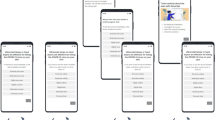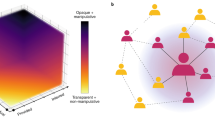Abstract
This paper documents the existence of a ‘formality effect’ in government communications. Across three online studies and three field experiments in different policy contexts (total N = 67,632), we show that, contrary to researcher and practitioner predictions, formal government communications are more effective at influencing resident behaviour than informal government communications. In exploring mechanisms, we show that formality operates as a heuristic for credibility and importance. Recipients view the source of a formal letter as more competent and trustworthy, and view the request itself as more important to take action on, despite no evidence of change in comprehension or in perceived ease of taking action. These findings have immediate implications for government communicators and open the door for a renewed focus on how the design and presentation of information impacts behaviour.
This is a preview of subscription content, access via your institution
Access options
Access Nature and 54 other Nature Portfolio journals
Get Nature+, our best-value online-access subscription
$29.99 / 30 days
cancel any time
Subscribe to this journal
Receive 12 digital issues and online access to articles
$119.00 per year
only $9.92 per issue
Buy this article
- Purchase on Springer Link
- Instant access to full article PDF
Prices may be subject to local taxes which are calculated during checkout

Similar content being viewed by others
Data availability
All data from the prediction survey and Studies 1, 4, 5 and 6 are available on OSF at https://osf.io/akh9b/. Accredited researchers can access data for Studies 2 and 3 after signing a data sharing agreement with BIT. Requests for data for Studies 2 and 3 can be directed to BIT.
Code availability
All code is available on OSF at https://osf.io/akh9b/.
References
Bhargava, S. & Manoli, D. Psychological frictions and the incomplete take-up of social benefits: evidence from an IRS field experiment. Am. Econ. Rev. 105, 3489–3529 (2015).
Milkman, K. L. et al. A megastudy of text-based nudges encouraging patients to get vaccinated at an upcoming doctor’s appointment. Proc. Natl Acad. Sci. USA 118, e2101165118 (2021).
Thaler, R. H. & Sunstein, C. R. Nudge: Improving Decisions about Health, Wealth, and Happiness (Penguin, 2009).
Robitaille, N., House, J. & Mazar, N. Effectiveness of planning prompts on organizations’ likelihood to file their overdue taxes: a multi-wave field experiment. Manage. Sci. 67, 4327–4340 (2020).
Bhanot, S. & Hopkins, D. J. Partisan polarization and resistance to elite messages: results from a survey experiment on social distancing. SSRN https://doi.org/10.2139/ssrn.3593450 (2020).
Grimmelikhuijsen, S., Jilke, S., Olsen, A. L. & Tummers, L. Behavioral public administration: combining insights from public administration and psychology. Public Adm. Rev. 77, 45–56 (2017).
Hall, C. C. & Jurcevic, I. Behavioral Insights for Public Policy: Contextualizing Our Science Elements in Applied Social Psychology (Cambridge University Press, 2022); https://doi.org/10.1017/9781009028806
Nickerson, D. W. & Rogers, T. Do you have a voting plan? Implementation intentions, voter turnout, and organic plan making. Psychol. Sci. 21, 194–199 (2010).
Dai, H. et al. Behavioural nudges increase COVID-19 vaccinations. Nature 597, 404–409 (2021).
Gerber, A. S. & Rogers, T. Descriptive social norms and motivation to vote: everybody’s voting and so should you. J. Polit. 71, 178–191 (2009).
Herd, P. & Moynihan, D. P. Administrative Burden: Policymaking by Other Means (Russell Sage Foundation, 2019).
Lasky-Fink, J., Robinson, C., Chang, H. & Rogers, T. Using behavioral insights to improve school administrative communications: the case of truancy notifications. Educ. Res. 50, 442–450 (2021).
Milkman, K. L., Beshears, J., Choi, J. J., Laibson, D. & Madrian, B. C. Using implementation intentions prompts to enhance influenza vaccination rates. Proc. Natl Acad. Sci. USA 108, 10415–10420 (2011).
Finkelstein, A. & Notowidigdo, M. J. Take-up and targeting: experimental evidence from SNAP. Q. J. Econ. 134, 1505–1556 (2019).
Hallsworth, M., List, J. A., Metcalfe, R. D. & Vlaev, I. The Making of Homo Honoratus: From Omission to Commission Working Paper No. 21210 (National Bureau of Economic Research, 2015); 10.3386/w21210
Linos, E., Prohofsky, A., Ramesh, A., Rothstein, J. & Unrath, M. Can nudges increase take-up of the EITC? Evidence from multiple field experiments. Am. Econ. J. Econ. Policy 14, 432–452 (2022).
Increasing School Attendance: Seattle—Proactive Communications Do Not Change Attendance Outcomes (Office of Evaluation Sciences, 2019); https://oes.gsa.gov/assets/abstracts/1809-abstract-school-attendance-seattle.pdf
Poulin, R. The Language of Graphic Design Revised and Updated: An Illustrated Handbook for Understanding Fundamental Design Principles (Rockport, 2018).
Resnick, E. Design for Communication: Conceptual Graphic Design Basics (John Wiley & Sons, 2003).
Rodríguez Estrada, F. C. & Davis, L. S. Improving visual communication of science through the incorporation of graphic design theories and practices into science communication. Sci. Commun. 37, 140–148 (2015).
Hilchey, M. D., Osborne, M. & Soman, D. Does the visual salience of credit card features affect choice? Behav. Public Policy https://doi.org/10.1017/bpp.2021.14 (2021).
Wedel, M. & Pieters, R. A review of eye-tracking research in marketing. Rev. Mark. Res. 4, 123–147 (2008).
Barcelos, R. H., Dantas, D. C. & Senecal, S. Watch your tone: how a brand’s tone of voice on social media influences consumer responses. J. Interact. Mark. 41, 60–80 (2018).
Gretry, A., Horváth, C., Belei, N. & van Riel, A. C. R. ‘Don’t pretend to be my friend!’ When an informal brand communication style backfires on social media. J. Bus. Res. 74, 77–89 (2017).
Kelleher, T. Conversational voice, communicated commitment, and public relations outcomes in interactive online communication. J. Commun. 59, 172–188 (2009).
Liebrecht, C., Tsaousi, C. & van Hooijdonk, C. Linguistic elements of conversational human voice in online brand communication: manipulations and perceptions. J. Bus. Res. 132, 124–135 (2021).
Childers, T. L. & Jass, J. All dressed up with something to say: effects of typeface semantic associations on brand perceptions and consumer memory. J. Consum. Psychol. 12, 93–106 (2002).
Luangrath, A. W., Peck, J. & Barger, V. A. Textual paralanguage and its implications for marketing communications. J. Consum. Psychol. 27, 98–107 (2017).
Evans, M. B., McBride, A. A., Queen, M., Thayer, A. & Spyridakis, J. H. The effect of style and typography on perceptions of document tone. In Proc. International Professional Communication Conference, 2004 300–303 (IEEE, 2004); https://doi.org/10.1109/IPCC.2004.1375314
Thayer, A., Evans, M. B., McBride, A. A., Queen, M. & Spyridakis, J. H. I, pronoun: a study of formality in online content. J. Tech. Writ. Commun. 40, 447–458 (2010).
Cialdini, R. B. Influence: The Psychology of Persuasion revised edn (Harper Business, 2006).
McGuire, W. J. in Behavioral and Management Sciences in Marketing (eds Davis, H. L. & Silk, A. J.) 156–180 (Wiley, 1978); https://doi.org/10.1080/00913367.1979.10717982
Pornpitakpan, C. The persuasiveness of source credibility: a critical review of five decades’ evidence. J. Appl. Soc. Psychol. 34, 243–281 (2004).
Aronson, E., Turner, J. A. & Carlsmith, J. M. Communicator credibility and communication discrepancy as determinants of opinion change. J. Abnorm. Soc. Psychol. 67, 31–36 (1963).
Jones, L. W., Sinclair, R. C. & Courneya, K. S. The effects of source credibility and message framing on exercise intentions, behaviors, and attitudes: an integration of the elaboration likelihood model and prospect theory. J. Appl. Soc. Psychol. 33, 179–196 (2003).
Kareklas, I., Muehling, D. D. & Weber, T. J. Reexamining health messages in the digital age: a fresh look at source credibility effects. J. Advert. 44, 88–104 (2015).
Mizerski, R. W., Golden, L. L. & Kernan, J. B. The attribution process in consumer decision making. J. Consum. Res. 6, 123–140 (1979).
Hovland, C. I. & Weiss, W. The influence of source credibility on communication effectiveness. Public Opin. Q. 15, 635–650 (1951).
Kumagai, S. & Iorio, F. Building Trust in Government through Citizen Engagement (World Bank, 2020); https://openknowledge.worldbank.org/bitstream/handle/10986/33346/Building-Trust-in-Government-through-Citizen-Engagement.pdf
Americans’ Views of Government: Decades of Distrust, Enduring Support for Its Role (Pew Research Center, 2022); https://www.pewresearch.org/politics/2022/06/06/americans-views-of-government-decades-of-distrust-enduring-support-for-its-role/
Many Believe Misinformation Is Increasing Extreme Political Views and Behaviors (AP-NORC Center for Public Affairs Research, 2022); https://apnorc.org/projects/many-believe-misinformation-is-increasing-extreme-political-views-and-behaviors
Bullock, O. M. & Hubner, A. Y. Candidates’ use of informal communication on social media reduces credibility and support: examining the consequences of expectancy violations. Commun. Res. Rep. 37, 87–98 (2020).
Fishbane, A., Ouss, A. & Shah, A. K. Behavioral nudges reduce failure to appear for court. Science https://doi.org/10.1126/science.abb6591 (2020).
Reiff, J. S., Dai, H., Beshears, J., Milkman, K. L. & Benartzi, S. Save more today or tomorrow: the role of urgency in pre-commitment design. J. Mark. Res. https://doi.org/10.1177/00222437231153396 (2023).
Roux, C., Goldsmith, K. & Bonezzi, A. On the psychology of scarcity: when reminders of resource scarcity promote selfish (and generous) behavior. J. Consum. Res. 42, 615–631 (2015).
Kim, S., Zhang, X. A. & Zhang, B. W. Self-mocking crisis strategy on social media: focusing on Alibaba chairman Jack Ma in China. Public Relat. Rev. 42, 903–912 (2016).
Xiao, Y., Cauberghe, V. & Hudders, L. Humour as a double-edged sword in response to crises versus rumours: the effectiveness of humorously framed crisis response messages on social media. J. Contingencies Crisis Manage. 26, 247–260 (2018).
West, D. M. Equity and accessibility in e-government: a policy perspective. J. E-Gov. https://doi.org/10.1300/J399v01n02_03 (2008).
Castelo, N. et al. Moving Citizens Online: Using Salience and Message Framing to Motivate Behavior Change (Behavioral Science and Policy Association, 2015); https://behavioralpolicy.org/wp-content/uploads/2017/05/BSP_vol1is2_-Castelo.pdf
Linos, E. & Riesch, N. Thick red tape and the thin blue line: a field study on reducing administrative burden in police recruitment. Public Adm. Rev. 80, 92–103 (2020).
Plain Writing Act, 5 U.S.C. § 105 https://www.govinfo.gov/app/details/PLAW-111publ274 (2010).
DellaVigna, S. & Linos, E. RCTs to scale: comprehensive evidence from two nudge units. Econometrica 90, 81–116 (2022).
Weinstein, E. A. & Deutschberger, P. Some dimensions of altercasting. Sociometry 26, 454–466 (1963).
Sheeran, P. & Webb, T. L. The intention–behavior gap. Soc. Pers. Psychol. Compass 10, 503–518 (2016).
StataCorp. Stata Statistical Software: Version 15 (StataCorp LLC, 2017).
Acknowledgements
We thank BIT, our city government partners, and E. Cardon, K. Reddy and S. Tregebov at BIT Americas for work on Studies 2 and 3. We thank the California Policy Lab, Franchise Tax Board and Golden State Opportunity for collaboration on Study 4. We also thank seminar participants at Indiana University, the Society for Judgment and Decision Making annual conference and the Public Management Research Conference for feedback on the manuscript. Finally, we thank Bloomberg Philanthropies for funding for the BIT Americas studies. The funders had no role in study design, data collection and analysis, decision to publish or preparation of the manuscript.
Author information
Authors and Affiliations
Contributions
All authors contributed to the design of Studies 1, 5 and 6. As former employees of BIT, E.L., E.K. and L.M. contributed to the design and evaluation of Study 2. As former employees of BIT, E.K. and L.M. contributed to the design and evaluation of Study 3. E.L. contributed to the design and evaluation of Study 4. J.L.-F. conducted and led the analysis for Studies 1, 5 and 6. All authors contributed to writing the manuscript.
Corresponding author
Ethics declarations
Competing interests
The authors declare no competing interests.
Peer review
Peer review information
Nature Human Behaviour thanks Austin Hubner, Christine Liebrecht and the other, anonymous, reviewer(s) for their contribution to the peer review of this work.
Additional information
Publisher’s note Springer Nature remains neutral with regard to jurisdictional claims in published maps and institutional affiliations.
Supplementary information
Supplementary Information
Supplementary Figs. 1–8, Tables 1–18, Methods and references.
Rights and permissions
Springer Nature or its licensor (e.g. a society or other partner) holds exclusive rights to this article under a publishing agreement with the author(s) or other rightsholder(s); author self-archiving of the accepted manuscript version of this article is solely governed by the terms of such publishing agreement and applicable law.
About this article
Cite this article
Linos, E., Lasky-Fink, J., Larkin, C. et al. The formality effect. Nat Hum Behav 8, 300–310 (2024). https://doi.org/10.1038/s41562-023-01761-z
Received:
Accepted:
Published:
Issue Date:
DOI: https://doi.org/10.1038/s41562-023-01761-z



